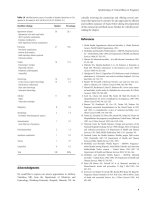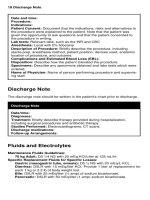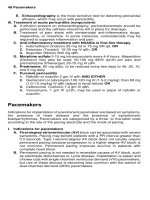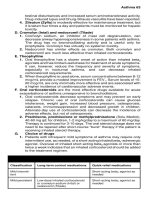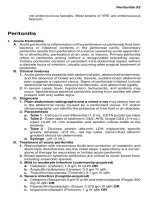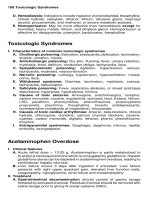Pediatric critical care medicine, volume 3 gastroenterological, endocrine, renal, hematologic, oncologic and immune systems, 2e (2014)
Bạn đang xem bản rút gọn của tài liệu. Xem và tải ngay bản đầy đủ của tài liệu tại đây (11.92 MB, 620 trang )
Derek S. Wheeler
Hector R. Wong
Thomas P. Shanley
Editors
Pediatric Critical
Care Medicine
Volume 3:
Gastroenterological,
Endocrine, Renal,
Hematologic, Oncologic
and Immune Systems
Second Edition
123
Pediatric Critical Care Medicine
Derek S. Wheeler • Hector R. Wong
Thomas P. Shanley
Editors
Pediatric Critical Care Medicine
Volume 3: Gastroenterological,
Endocrine, Renal, Hematologic,
Oncologic and Immune Systems
Second Edition
Editors
Derek S. Wheeler, MD, MMM
Division of Critical Care Medicine
Cincinnati Children’s Hospital Medical Center
University of Cincinnati College of Medicine
Cincinnati, OH
USA
Thomas P. Shanley, MD
Michigan Institute for Clinical
and Health Research
University of Michigan Medical School
Ann Arbor, MI
USA
Hector R. Wong, MD
Division of Critical Care Medicine
Cincinnati Children’s Hospital Medical Center
University of Cincinnati College of Medicine
Cincinnati, OH
USA
ISBN 978-1-4471-6415-9
ISBN 978-1-4471-6416-6
DOI 10.1007/978-1-4471-6416-6
Springer London Heidelberg New York Dordrecht
(eBook)
Library of Congress Control Number: 2014942837
© Springer-Verlag London 2014
This work is subject to copyright. All rights are reserved by the Publisher, whether the whole or part of the material is
concerned, specifically the rights of translation, reprinting, reuse of illustrations, recitation, broadcasting, reproduction
on microfilms or in any other physical way, and transmission or information storage and retrieval, electronic adaptation,
computer software, or by similar or dissimilar methodology now known or hereafter developed. Exempted from this
legal reservation are brief excerpts in connection with reviews or scholarly analysis or material supplied specifically
for the purpose of being entered and executed on a computer system, for exclusive use by the purchaser of the work.
Duplication of this publication or parts thereof is permitted only under the provisions of the Copyright Law of the
Publisher's location, in its current version, and permission for use must always be obtained from Springer. Permissions
for use may be obtained through RightsLink at the Copyright Clearance Center. Violations are liable to prosecution
under the respective Copyright Law.
The use of general descriptive names, registered names, trademarks, service marks, etc. in this publication does not
imply, even in the absence of a specific statement, that such names are exempt from the relevant protective laws and
regulations and therefore free for general use.
While the advice and information in this book are believed to be true and accurate at the date of publication, neither
the authors nor the editors nor the publisher can accept any legal responsibility for any errors or omissions that may
be made. The publisher makes no warranty, express or implied, with respect to the material contained herein.
Printed on acid-free paper
Springer is part of Springer Science+Business Media (www.springer.com)
For Cathy, Ryan, Katie, Maggie, and Molly
“You don’t choose your family. They are God’s gift to you…”
Desmond Tutu
Foreword to the First Edition
The practitioner of Pediatric Critical Care Medicine should be facile with a broad scope of
knowledge from human developmental biology, to pathophysiologic dysfunction of virtually
every organ system, and to complex organizational management. The practitioner should
select, synthesize and apply the information in a discriminative manner. And finally and most
importantly, the practitioner should constantly “listen” to the patient and the responses to
interventions in order to understand the basis for the disturbances that create life-threatening
or severely debilitating conditions.
Whether learning the specialty as a trainee or growing as a practitioner, the pediatric intensivist must adopt the mantle of a perpetual student. Every professional colleague, specialist
and generalist alike, provides new knowledge or fresh insight on familiar subjects. Every
patient presents a new combination of challenges and a new volley of important questions to
the receptive and inquiring mind.
A textbook of pediatric critical care fills special niches for the discipline and the student of
the discipline. As an historical document, this compilation records the progress of the specialty. Future versions will undoubtedly show advances in the basic biology that are most
important to bedside care. However, the prevalence and manifestation of disease invariably
will shift, driven by epidemiologic forces, and genetic factors, improvements in care and,
hopefully, by successful prevention of disease. Whether the specialty will remain as broadly
comprehensive as is currently practiced is not clear, or whether sub-specialties such as cardiacand neurointensive care will warrant separate study and practice remains to be determined.
As a repository of and reference for current knowledge, textbooks face increasing and
imposing limitations compared with the dynamic and virtually limitless information gateway
available through the internet. Nonetheless, a central standard serves as a defining anchor from
which students and their teachers can begin with a common understanding and vocabulary and
thereby support their mutual professional advancement. Moreover, it permits perspective,
punctuation and guidance to be superimposed by a thoughtful expert who is familiar with the
expanding mass of medical information.
Pediatric intensivists owe Drs. Wheeler, Wong, and Shanley a great debt for their work in
authoring and editing this volume. Their effort was enormously ambitious, but matched to the
discipline itself in depth, breadth, and vigor. The scientific basis of critical care is integrally
woven with the details of bedside management throughout the work, providing both a satisfying rationale for current practice, as well as a clearer picture of where we can improve. The
coverage of specialized areas such as intensive care of trauma victims and patients following
congenital heart surgery make this a uniquely comprehensive text. The editors have assembled
an outstanding collection of expert authors for this work. The large number of international
contributors is striking, but speaks to the rapid growth of this specialty throughout the world.
We hope that this volume will achieve a wide readership, thereby enhancing the exchange
of current scientific and managerial knowledge for the care of critically ill children, and stimulating the student to seek answers to fill our obvious gaps in understanding.
Chicago, IL, USA
New Haven, CT, USA
Thomas P. Green
George Lister
vii
Preface to the Second Edition
The specialty of pediatric critical care medicine continues to grow and evolve! The modern
PICU of today is vastly different, even compared to as recently as 5 years ago. Technological
innovations in the way we approach the diagnosis and treatment of critically ill children have
seemingly changed overnight in some cases. Efforts at prevention and improvements in care of
patients prior to coming to the PICU have led to better outcomes from critical illness. The
outcomes of conditions that were, even less than a decade ago, almost uniformly fatal have
greatly improved. Advances in molecular biology have led to the era of personalized medicine – we can now individualize our treatment approach to the unique and specific needs of a
patient. We now routinely rely on a vast array of condition-specific biomarkers to initiate and
titrate therapy. Some of these advances in molecular biology have uncovered new diseases and
conditions altogether! At the same time, pediatric critical care medicine has become more
global. We are sharing our knowledge with the world community. Through our collective
efforts, we are advancing the care of our patients. Pediatric critical care medicine will continue
to grow and evolve – more technological advancements and scientific achievements will surely
come in the future. We will become even more global in scope. However, the human element
of what pediatric critical care providers do will never change [1]. I remain humbled by the gifts
that I have received in my life. And I still remember the promise I made to myself so many
years ago – the promise that I would dedicate the rest of my professional career to advancing
the field of pediatric critical care medicine as payment for these gifts. It is my sincere hope that
the second edition of this textbook will educate a whole new generation of critical care
professionals, and in so-doing help me continue my promise.
References
1. Wheeler DS. Care of the critically ill pediatric patient. Pediatr Clin North Am 2013;60:xv–xvi. (wWith
permission by Elsevier, Inc)
Cincinnati, OH, USA
Derek S. Wheeler, MD, MMM
ix
Preface to the First Edition
Promises to Keep
The field of critical care medicine is growing at a tremendous pace, and tremendous advances
in the understanding of critical illness have been realized in the last decade. My family has
directly benefited from some of the technological and scientific advances made in the care of
critically ill children. My son Ryan was born during my third year of medical school. By some
peculiar happenstance, I was nearing completion of a 4-week rotation in the Newborn Intensive
Care Unit. The head of the Pediatrics clerkship was kind enough to let me have a few days off
around the time of the delivery – my wife Cathy was 2 weeks past her due date and had been
scheduled for elective induction. Ryan was delivered through thick meconium-stained amniotic fluid and developed breathing difficulty shortly after delivery. His breathing worsened
over the next few hours, so he was placed on the ventilator. I will never forget the feelings of
utter helplessness my wife and I felt as the NICU Transport Team wheeled Ryan away in the
transport isolette. The transport physician, one of my supervising third year pediatrics residents during my rotation the past month, told me that Ryan was more than likely going to
require ECMO. I knew enough about ECMO at that time to know that I should be scared! The
next 4 days were some of the most difficult moments I have ever experienced as a parent,
watching the blood being pumped out of my tiny son’s body through the membrane oxygenator and roller pump, slowly back into his body (Figs. 1 and 2). I remember the fear of each
Fig. 1
xi
xii
Preface to the First Edition
Fig. 2
day when we would be told of the results of his daily head ultrasound, looking for evidence of
intracranial hemorrhage, and then the relief when we were told that there was no bleeding. I
remember the hope and excitement on the day Ryan came off ECMO, as well as the concern
when he had to be sent home on supplemental oxygen. Today, Ryan is happy, healthy, and
strong. We are thankful to all the doctors, nurses, respiratory therapists, and ECMO specialists
who cared for Ryan and made him well. We still keep in touch with many of them. Without the
technological advances and medical breakthroughs made in the fields of neonatal intensive
care and pediatric critical care medicine, things very well could have been much different. I
made a promise to myself long ago that I would dedicate the rest of my professional career to
advancing the field of pediatric critical care medicine as payment for the gifts that we, my wife
and I, have been truly blessed. It is my sincere hope that this textbook, which has truly been a
labor of joy, will educate a whole new generation of critical care professionals, and in so-doing
help make that first step towards keeping my promise.
Cincinnati, OH, USA
Derek S. Wheeler, MD, MMM
Acknowledgements
With any such undertaking, there are people along the way who, save for their dedication,
inspiration, and assistance, a project such as this would never be completed. I am personally
indebted to Michael D. Sova, our Developmental Editor, who has been a true blessing. He has
kept this project going the entire way and has been an incredible help to me personally throughout the completion of this textbook. There were days when I thought that we would never finish – and he was always there to lift my spirits and keep me focused on the task at hand. I will
be forever grateful to him. I am also grateful for the continued assistance of Grant Weston at
Springer. Grant has been with me since the very beginning of the first edition of this textbook.
He has been a tremendous advocate for our specialty, as well as a great mentor and friend. I
would be remiss if I did not thank Brenda Robb for her clerical and administrative assistance
during the completion of this project. Juggling my schedule and keeping me on time during
this whole process was not easy! I have been extremely fortunate throughout my career to have
had incredible mentors, including Jim Lemons, Brad Poss, Hector Wong, and Tom Shanley.
All four are gifted and dedicated clinicians and remain passionate advocates for critically ill
children, the specialties of neonatology and pediatric critical care medicine, and me! I want to
personally thank both Hector and Tom for serving again as Associate Editors for the second
edition of this textbook. Their guidance and advice has been immeasurable. I have been truly
fortunate to work with an outstanding group of contributors. All of them are my colleagues and
many have been my friends for several years. It goes without saying that writing textbook
chapters is a difficult and arduous task that often comes without a lot of benefits. Their expertise and dedication to our specialty and to the care of critically ill children have made this
project possible. The textbook you now hold in your hands is truly their gift to the future of our
specialty. I would also like to acknowledge the spouses and families of our contributors – participating in a project such as this takes a lot of time and energy (most of which occurs outside
of the hospital!). Last, but certainly not least, I would like to especially thank my family – my
wife Cathy, who has been my best friend and companion, number one advocate, and sounding
board for the last 22 years, as well as my four children – Ryan, Katie, Maggie, and Molly, to
whom I dedicate this textbook and all that I do.
xiii
Contents
Part I
The Gastrointestinal System in Critical Illness and Injury
Derek S. Wheeler
1
Gastrointestinal Bleeding . . . . . . . . . . . . . . . . . . . . . . . . . . . . . . . . . . . . . . . . . . .
Brent Whittaker, Priya Prabhakaran, and Ujjal Poddar
3
2
Liver Failure in Infants and Children . . . . . . . . . . . . . . . . . . . . . . . . . . . . . . . . .
Ann E. Thompson
13
3
Acute Pancreatitis . . . . . . . . . . . . . . . . . . . . . . . . . . . . . . . . . . . . . . . . . . . . . . . . .
Raffaele Pezzilli
29
4
Abdominal Compartment Syndrome in Children . . . . . . . . . . . . . . . . . . . . . . .
Ori Attias and Gad Bar-Joseph
39
5
Obesity in Critical Illness . . . . . . . . . . . . . . . . . . . . . . . . . . . . . . . . . . . . . . . . . . .
Michael Hobson and Jennifer Kaplan
57
6
Nutrition in the PICU . . . . . . . . . . . . . . . . . . . . . . . . . . . . . . . . . . . . . . . . . . . . . .
Nilesh Mehta
69
Part II
The Endocrine System in Critical Illness and Injury
Jefferson P. Piva
7
Diabetic Ketoacidosis. . . . . . . . . . . . . . . . . . . . . . . . . . . . . . . . . . . . . . . . . . . . . . .
Jefferson P. Piva, Pedro Celiny Ramos Garcia, and Ricardo Garcia Branco
8
Hyperglycemia, Dysglycemia and Glycemic Control in Pediatric
Critical Care . . . . . . . . . . . . . . . . . . . . . . . . . . . . . . . . . . . . . . . . . . . . . . . . . . . . . .
Michael S.D. Agus, Edward Vincent S. Faustino, and Mark R. Rigby
83
93
9
Hypoglycemia . . . . . . . . . . . . . . . . . . . . . . . . . . . . . . . . . . . . . . . . . . . . . . . . . . . . .
Bettina von Dessauer and Derek S. Wheeler
103
10
The Adrenal Glands in Critical Illness and Injury. . . . . . . . . . . . . . . . . . . . . . .
Kusum Menon
109
11
Thyroid and Growth Hormone Axes Alteration
in the Critically Ill Child . . . . . . . . . . . . . . . . . . . . . . . . . . . . . . . . . . . . . . . . . . . .
Ricardo Garcia Branco, Pedro Celiny Ramos Garcia, and Jefferson P. Piva
Part III
12
119
The Renal System in Critical Illness and Injury
James D. Fortenberry
Applied Renal Physiology in the PICU . . . . . . . . . . . . . . . . . . . . . . . . . . . . . . . .
Ravi S. Samraj and Rajit K. Basu
129
xv
xvi
Contents
13
Electrolyte Disorders in the PICU . . . . . . . . . . . . . . . . . . . . . . . . . . . . . . . . . . . .
Gabriel J. Hauser and Aaron F. Kulick
147
14
Acid-Base Disorders in the PICU . . . . . . . . . . . . . . . . . . . . . . . . . . . . . . . . . . . . .
James D. Fortenberry, Kiran Hebbar, and Derek S. Wheeler
173
15
Acute Kidney Injury . . . . . . . . . . . . . . . . . . . . . . . . . . . . . . . . . . . . . . . . . . . . . . .
Rajit K. Basu
191
16
Kidney Disorders in the PICU: Thrombotic Microangiopathies
and Glomerulonephritis . . . . . . . . . . . . . . . . . . . . . . . . . . . . . . . . . . . . . . . . . . . .
Lyndsay A. Harshman, Patrick D. Brophy, and Carla M. Nester
213
17
Kidney Pharmacology . . . . . . . . . . . . . . . . . . . . . . . . . . . . . . . . . . . . . . . . . . . . . .
Maria José Santiago Lozano, Jesús López-Herce Cid,
and Andrés Alcaraz Romero
233
18
Renal Replacement Therapy. . . . . . . . . . . . . . . . . . . . . . . . . . . . . . . . . . . . . . . . .
Sue S. Sreedhar, Timothy E. Bunchman, and Norma J. Maxvold
241
Part IV
The Hematologic System in Critical Illness and Injury
Jacques Lacroix
19
Transfusion Medicine . . . . . . . . . . . . . . . . . . . . . . . . . . . . . . . . . . . . . . . . . . . . . .
Marisa Tucci, Jacques Lacroix, France Gauvin, Baruch Toledano,
and Nancy Robitaille
259
20
Hematologic Emergencies in the PICU . . . . . . . . . . . . . . . . . . . . . . . . . . . . . . . .
Martin C.J. Kneyber
287
21
Coagulation Disorders in the PICU . . . . . . . . . . . . . . . . . . . . . . . . . . . . . . . . . . .
Geoffrey M. Fleming and Gail M. Annich
297
22
Therapeutic Apheresis in the Pediatric Intensive Care Unit . . . . . . . . . . . . . . .
Stuart L. Goldstein
319
23
Thromboembolic Disorders in the PICU . . . . . . . . . . . . . . . . . . . . . . . . . . . . . . .
Ranjit S. Chima, Dawn Pinchasik, and Cristina Tarango
327
Part V
Oncologic Disorders in the PICU
Robert F. Tamburro Jr.
24
Care of the Oncology Patient in the PICU. . . . . . . . . . . . . . . . . . . . . . . . . . . . . .
Robert J. Greiner, Stacey Peterson-Carmichael, Jennifer A. Rothman,
Kenneth W. Gow, Robert F. Tamburro Jr., and Raymond Barfield
343
25
Critical Illness as a Result of Anti-Neoplastic Therapy . . . . . . . . . . . . . . . . . . .
Robert J. Greiner, Kevin M. Mulieri, Robert F. Tamburro Jr.,
and Raymond Barfield
363
26
Hemophagocytic Lymphohistiocytosis Syndromes. . . . . . . . . . . . . . . . . . . . . . .
Stephen W. Standage and Alexandra H. Filipovich
385
27
Hematopoietic Stem Cell Transplantation in the PICU . . . . . . . . . . . . . . . . . . .
Shilpa K. Shah, Sonata Jodele, Stella M. Davies, and Ranjit S. Chima
395
Contents
xvii
Part VI
The Immune System in Critical Illness and Injury
Derek S. Wheeler
28
The Immune System in Critical Illness and Injury . . . . . . . . . . . . . . . . . . . . . .
Jessica G. Moreland
421
29
Primary and Secondary Immunodeficiencies . . . . . . . . . . . . . . . . . . . . . . . . . . .
Rajesh K. Aneja and Alexandre T. Rotta
431
30
Sepsis . . . . . . . . . . . . . . . . . . . . . . . . . . . . . . . . . . . . . . . . . . . . . . . . . . . . . . . . . . .
James L. Wynn, Jan A. Hazelzet, Thomas P. Shanley, Hector R. Wong,
and Derek S. Wheeler
453
31
Thrombocytopenia-Associated Multiple Organ Failure Syndrome . . . . . . . . .
Trung C. Nguyen, Yong Y. Han, James D. Fortenberry, Zhou Zhou,
Miguel A. Cruz, and Joseph A. Carcillo Jr.
481
32
Toxic Shock Syndrome in Children . . . . . . . . . . . . . . . . . . . . . . . . . . . . . . . . . . .
Yu-Yu Chuang and Yhu-Chering Huang
493
33
Hospital-Acquired Infections
and the Pediatric Intensive Care Unit . . . . . . . . . . . . . . . . . . . . . . . . . . . . . . . . .
Erin Parrish Reade, Gregory A. Talbott, and Mark E. Rowin
509
34
Anaphylaxis . . . . . . . . . . . . . . . . . . . . . . . . . . . . . . . . . . . . . . . . . . . . . . . . . . . . . .
Shilpa K. Shah and Erika L. Stalets
531
35
Rheumatologic Disorders in the PICU. . . . . . . . . . . . . . . . . . . . . . . . . . . . . . . . .
Steven W. Martin and Michael R. Anderson
543
36
Infectious Disease-Associated Syndromes in the PICU . . . . . . . . . . . . . . . . . . .
Isaac Lazar and Clifford W. Bogue
567
37
Life Threatening Tropical Infections . . . . . . . . . . . . . . . . . . . . . . . . . . . . . . . . . .
Gabriela I. Botez and Lesley Doughty
577
Index . . . . . . . . . . . . . . . . . . . . . . . . . . . . . . . . . . . . . . . . . . . . . . . . . . . . . . . . . . . . . . .
607
Contributors
Michael S.D. Agus, MD Department of Medicine, Boston Children’s Hospital,
Harvard Medical School, Boston, MA, USA
Michael R. Anderson, MD, FAAP University Hospitals Case Medical Center,
Cleveland, OH, USA
Rajesh K. Aneja, MD Critical Care Medicine, Children’s Hospital of Pittsburgh of UPMC,
Pittsburgh, PA, USA
Gail M. Annich, MD Department of Pediatrics and Communicable Diseases,
University of Michigan School of Medicine, Ann Arbor, MI, USA
Ori Attias, MD Pediatric Intensive Care Unit, Meyer Children’s Hospital,
Rambam Medical Center, Haifa, Israel
Raymond Barfield, MD, PhD Department of Pediatric Hematology/Oncology,
Duke University, Durham, NC, USA
Gad Bar-Joseph, MD Department of Pediatric Intensive Care, Meyer Children’s Hospital,
Rambam Medical Center, Haifa, Israel
Rajit K. Basu, MD Pediatric Critical Care, Cincinnati Children’s Hospital
and Medical Center, Cincinnati, OH, USA
Clifford W. Bogue, MD Department of Pediatrics, Yale School of Medicine,
New Haven, CT, USA
Gabriela I. Botez, MD Department of Pediatric Cardiology, University of Alberta, Stollery
Children’s Hospital, Edmonton, Alberta, Canada
Ricardo Garcia Branco, MD, PhD Department of Pediatric Intensive Care Unit,
Addenbrookes Hospital, Cambridge, Cambridgeshire, UK
Patrick D. Brophy, MD Department of Pediatrics, University of Iowa Children’s Hospital,
Iowa City, IA, USA
Timothy E. Bunchman, MD Department of Pediatric Nephrology, Children’s Hospital
of Richmond, Viriginia Commonwealth University School of Medicine,
Richmond, VA, USA
Joseph A. Carcillo Jr., MD Pediatric Intensive Care Unit, Children’s Hospital
of Pittsburgh of UPMC, Pittsburgh, PA, USA
Ranjit S. Chima, MD Division of Critical Care Medicine, Cincinnati Children’s Hospital
Medical Center, Cincinatti, OH, USA
Yu-Yu Chuang, MD Department of Pediatrics, St. Mary’s Hospital, Luodong,
Luodong, Yilan, Taiwan
xix
xx
Jesús López-Herce Cid, MD PhD Pediatric Critical Care Department,
Hospital General Universitario Gregorio Marañón, Madrid, Spain
Miguel A. Cruz, PhD Medicine/Cardiovascular Research Section, Houston, TX, USA
Stella M. Davies, MBBS, PhD Division of Bone Marrow Transplantation
and Immune Deficiency, Cincinnati Children’s Hospital Medical Center,
Cincinnati, OH, USA
Lesley Doughty, MD Department of Critical Care Medicine, Cincinnati Children’s
Hospital Medical Center, Cincinnati, OH, USA
Edward Vincent S. Faustino, MD Department of Pediatrics, Yale School of Medicine,
New Haven, CT, USA
Alexandra H. Filipovich, MD Cancer and Blood Diseases Institute/ Bone
Marrow Transplantation, Cincinnati Children’s Hospital Medical Center,
Cincinnati, OH, USA
Geoffrey M. Fleming, MD Division of Critical Care Medicine, Department of Pediatrics,
Vanderbilt University School of Medicine, Nashville, TN, USA
James D. Fortenberry, MD, MCCM, FAAP Department of Pediatric Critical Care,
Children’s Healthcare of Atlanta/Emory University School of Medicine, Atlanta, GA, USA
Pedro Celiny Ramos Garcia, MD, PhD Pediatric Department, Hospital São
Lucas da PUCRS, Porto Alegre, RS, Brazil
Pediatric Intensive Care Unit, H. São Lucas da PUCRS, Porto Alegre, RS, Brazil
Department of Pediatrics, School of Medicine, Pontificia Universidade Católica do Rio
Grande do Sul (PUCRS), Porto Alegre, RS, Brazil
France Gauvin, MD, FRCPC, MSc Division of Pediatric Critical Care Medicine,
Department of Pediatrics, Faculté de Médecine, Sainte-Justine Hospital,
Université de Montréal, Montreal, Canada
Stuart L. Goldstein, MD Department of Pediatrics, Center for Acute Care Nephrology,
Cincinnati Children’s Hospital Medical Center, Cincinnati, OH, USA
Kenneth W. Gow, MSc, MD, FRCSC, FACS Department of General and Thoracic Surgery,
Seattle Children’s Hospital, University of Washington, Seattle, WA, USA
Robert J. Greiner, MD Division of Hematology/Oncology, Department of Pediatrics,
Penn State Hershey Children’s Hospital, Hershey, PA, USA
Yong Y. Han, MD Department of Critical Care Medicine, Children’s Mercy
Hospital and Clinics, Kansas City, MO, USA
Lyndsay A. Harshman, MD Department of Pediatrics, University of Iowa
Children’s Hospital, Iowa City, IA, USA
Gabriel J. Hauser, MD, MBA Pediatrics, Pharmacology and Physiology,
Department of Pediatrics, Critical Care and Pulmonary Medicine,
Medstar Georgetown University Hospital, Washington, DC, USA
Jan A. Hazelzet, MD, PhD Department of Pediatrics, Erasmus MC, Sophia
Children’s Hospital, Rotterdam, The Netherlands
Kiran Hebbar, MD, FCCM, FAAP Department of Pediatrics, Emory University
and Children’s Healthcare of Atlanta at Egleston, Atlanta, GA, USA
Contributors
Contributors
xxi
Michael Hobson, MD Division of Critical Care Medicine, Pediatric Critical Care Medicine,
Cincinnati Children’s Hospital Medical Center, University of Cincinnati
College of Medicine, Cincinnati, OH, USA
Yhu-Chering Huang, MD, PhD Department of Pediatrics, Chang Gung
Memorial Hospital, Kweishan, Taoyuan, Taiwan
Sonata Jodele, MD Division of Bone Marrow Transplantation and Immune Deficiency,
Cincinnati Children’s Hospital Medical Center, Cincinnati, OH, USA
Jennifer Kaplan, MD, MS Division of Critical Care Medicine, Cincinnati Children’s
Hospital Medical Center, Cincinnati, OH, USA
Martin C.J. Kneyber, MD, PhD Division of Paediatric Intensive Care,
Department of Paediatrics, Beatrix Children’s Hospital, University Medical Centre
Groningen, The University of Groningen, Groningen, The Netherlands
Aaron F. Kulick, MD Nephrology and Endocrinology, Pittsburgh, PA, USA
Jacques Lacroix, MD Department of Pediatrics, Sainte-Justine Hospital,
Montreal, QC, Canada
Isaac Lazar, MD Pediatric Intensive Care Unit, Soroka Medical Center, Beer Sheva, Israel
Maria José Santiago Lozano, MD, PhD Pediatric Critical Care Department,
Hospital General Universitario Gregorio Marañón, Madrid, Spain
Steven W. Martin, MD Department of Pediatrics, Sparrow Hospital Children’s Center,
Lansing, MI, USA
Norma J. Maxvold, MD Department of Pediatrics Critical Care Medicine,
Children’s Hospital of Richmond, Richmond, VA, USA
Nilesh Mehta, MD Department of Critical Care Medicine, Children’s Hospital Boston,
Boston, MA, USA
Department of Anesthesia, Harvard Medical School, Boston, MA, USA
Kusum Menon, MD, MSc Department of Pediatrics, Children’s Hospital
of Eastern Ontario, Ottawa, ON, Canada
Jessica G. Moreland, MD Department of Pediatrics, UT Southwestern Medical Center,
Dallas, TX, USA
Kevin M. Mulieri, BS, Pharm. D. Pharmacy Department, Penn State Hershey
Medical Center, Hershey, PA, USA
Carla M. Nester, MD Department of Internal Medicine and Pediatrics,
University of Iowa Hospitals and Clinics, Iowa City, IA, USA
Trung C. Nguyen, MD Department of Pediatrics, Texas Children’s Hospital/Baylor
College of Medicine, Houston, TX, USA
Stacey Peterson-Carmichael, MD Divisions of Pediatric Critical Care and Pediatric
Pulmonary and Sleep Medicine, Department of Pediatrics, Duke University Medical Center,
Durham, NC, USA
Raffaele Pezzilli, MD Department of Digestive Diseases and Internal Medicine,
Sant’Orsola-Malpighi, Bologna, Italy
Dawn Pinchasik, MD Cancer and Blood Diseases Institute, Cincinnati Children’s Hospital
Medical Center, Cincinnati, OH, USA
xxii
Jefferson P. Piva, MD, PhD Pediatric Emergency and Critical Care Department, Hospital
de Clinicas de Porto Alegre-Brazil, Porto Alegre (RS), Brazil
Department of Pediatrics, School of Medicine, Universidade Federal do Rio Grande do Sul
(UFGRS), Rua Ramiro Barcelos, Porto Alegre (RS), Brazil
Ujjal Poddar, MD Department of Pediatric Gastroenterology, Sanjay Gandhi Postgraduate
Institute of Medical Sciences, Lucknow, Uttar Pradesh, India
Priya Prabhakaran, MD Department of Pediatrics, Section of Critical Care,
Children’s of Alabama, Birmingham, AL, USA
Erin Parrish Reade, MD, MPH Division of Critical Care, Department of Pediatrics,
University of Tennessee College of Medicine-Chattanooga, Children’s Hospital at Erlanger,
Chattanooga, TN, USA
Mark R. Rigby, MD, PhD, FAAP, FCCM Department of Pediatrics, Indiana University
School of Medicine and Riley Hospital for Children, Indianapolis, IN, USA
Nancy Robitaille, MD, FRCPC Division of Hematology-Oncology,
Department of Pediatrics, Faculté de Médecine, Sainte-Justine Hospital,
Université de Montréal, Montreal, Canada
Andrés Alcaraz Romero, MD, PhD Pediatric Critical Care Department, Hospital General
Universitario Gregorio Marañón, Madrid, Spain
Jennifer A. Rothman, MD Department of Pediatrics, Duke University Medical Center,
Durham, NC, USA
Alexandre T. Rotta, MD, FCCM, FAAP Department of Pediatrics,
Riley Hospital for Children at Indiana University Health, Cleveland, OH, USA
Mark E. Rowin, MD Department of Pediatrics, Children’s Hospital at Erlanger,
Chattanooga, TN, USA
Ravi S. Samraj, MD Department of Pediatric Critical Care, Cincinnati Children’s Hospital
and Medical Center, Cincinnati, OH, USA
Shilpa K. Shah, DO Division of Critical Care Medicine, Department of Pediatrics,
Cincinnati Children’s Hospital Medical Center, Cincinnati, OH, USA
Thomas P. Shanley, MD Michigan Institute for Clinical and Health Research,
University of Michigan Medical School, Ann Arbor, MI, USA
Sue S. Sreedhar, MD Department of Pediatric Intensive Care Unit,
Virginia Commonwealth University, Children’s Hospital of Richmond, Richmond, VA, USA
Erika L. Stalets, MD Division of Critical Care Medicine, Department of Pediatrics,
Cincinnati Children’s Hospital Medical Center, Cincinnati, OH, USA
Stephen W. Standage, MD Pediatric Critical Care Medicine, Center for Lung Biology
Seattle Children’s Hospital and University of Washington School of Medicine,
Seattle, WA, USA
Gregory A. Talbott, MD Department of Pediatrics, Children’s Hospital at Erlanger,
Chattanooga, TN, USA
Robert F. Tamburro Jr., MD, MSc Department of Pediatrics, Penn State Hershey
Children’s Hospital, Hershey, PA, USA
Cristina Tarango, MD Division of Hematology, Cincinnati Children’s Hospital
Medical Center, Cincinnati, OH, USA
Contributors
Contributors
xxiii
Ann E. Thompson, MD, MHCPM Department of Critical Care Medicine,
Children’s Hospital of Pittsburgh, University of Pittsburgh School of Medicine,
Pittsburgh, PA, USA
Baruch Toledano, MD, FRCPC, MSc Division of Pediatric Critical Care Medicine,
Department of Pediatrics, Faculté de Médecine, Sainte-Justine Hospital, Université de
Montréal, Montreal, Canada
Marisa Tucci, MD Department of Pediatrics, Sainte-Justine Hospital,
University of Montreal, Montreal, QC, Canada
Bettina von Dessauer, MD, MSc Pediatric Intensive Care Unit, Roberto del Río,
Santiago, Chile
Derek S. Wheeler, MD, MMM Division of Critical Care Medicine,
Cincinnati Children’s Hospital Medical Center, University of Cincinnati
College of Medicine, Cincinnati, OH, USA
Brent Whittaker, MD Department of Pediatrics, Section of Critical Care, Spectrum Health,
Grand Rapids, MI, USA
Hector R. Wong, MD Division of Critical Care Medicine, Cincinnati Children’s Hospital
Medical Center, Cincinnati, OH, USA
James L. Wynn, MD Department of Pediatrics, Monroe Carell Jr. Children’s
Hospital at Vanderbilt, Nashville, TN, USA
Zhou Zhou, MD, PhD State Key Laboratory of Cardiovascular Disease,
Fuwai Hospital, Chinese Academy of Medical Sciences and Peking Union Medical College,
Beijing, People’s Republic of China
Part I
The Gastrointestinal System
in Critical Illness and Injury
Derek S. Wheeler

